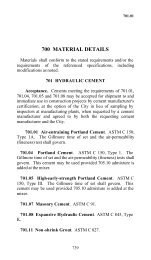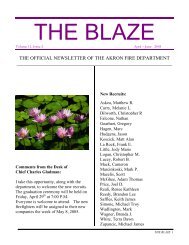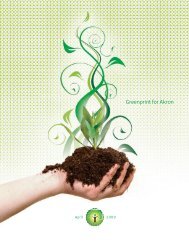Akron Water Pollution Control Station No Feasible Alternative
Akron Water Pollution Control Station No Feasible Alternative
Akron Water Pollution Control Station No Feasible Alternative
Create successful ePaper yourself
Turn your PDF publications into a flip-book with our unique Google optimized e-Paper software.
<strong>Akron</strong> WPCS personnel performed two in-house stress tests prior to the Facilities Plan 98 6 to<br />
evaluate the secondary treatment performance and capabilities. The first stress test was<br />
performed between December 1992 and January 1994 (Activated Sludge Plant Stress Test,<br />
1994 3 ). A second stress test was mandated by the July 17, 1995 Consent Decree. The second<br />
stress test was performed from March 1997 to September 1997 (Activated Sludge Plant Stress<br />
Test, 1997 4 ).<br />
A third stress test was performed in <strong>No</strong>vember/December 2006 and is being reported as part of<br />
this Report. All three stress test reports are provided in Appendix A. The following is a summary<br />
of the three stress test results.<br />
1993 Stress Test<br />
The <strong>Akron</strong> WPCS secondary treatment (activated sludge plant) facility was operated at higher<br />
than normal flow rates on 18 separate occasions in 1993 to intentionally stress the performance<br />
of these facilities. These stress test events ranged from a 1.75 hours duration to a maximum of<br />
34.5 hours. Target flow rates were 110, 115, 120 and 130 MGD. The complete stress test report<br />
is provided in Appendix A.<br />
The following is a synopsis of test observations:<br />
• Observations of “severe degradation” were made at sustained flows of 110 MGD. Short<br />
“upsets” were experienced. Sludge blankets were within 6 inches of the effluent launders.<br />
However, discharge permit parameters were being met.<br />
• Total Suspended Solids (TSS) effluent concentrations of 38 mg/l were seen at a 115 MGD<br />
test flow after only two hours. Plant personnel were unable to restart the test. TSS<br />
concentrations exceeded permit limits on forty-four occasions over the next five months;<br />
they were believed to have resulted from a loss of biomass and nitrifiers during the cold<br />
weather stress test.<br />
• The CBOD5 and TSS concentrations were at or above permit limits during two, 120 MGD<br />
stress test events in <strong>No</strong>vember 1993.<br />
“Plant personnel proposed the following additional conclusions based on their 1993 stress test<br />
experience:<br />
• the recovery phase for the secondary treatment (activated sludge) plant after an event of<br />
110 MGD requires at least a three mean cell residence time (MCRT) duration for proper<br />
recovery before continuation of stress testing (experiencing additional high flow events);<br />
• continued and/or frequent storm events will degrade the activated sludge treatment level for<br />
any extended period of flows over 100 MGD;<br />
• physical flooding of the aeration tanks occurs at flows over 110 MGD;<br />
• flooding (weir submergence) of the final settling tanks occurs during extended high flow<br />
events;<br />
• hydraulic capacity of the aeration basins is limited;<br />
Page 3-10







